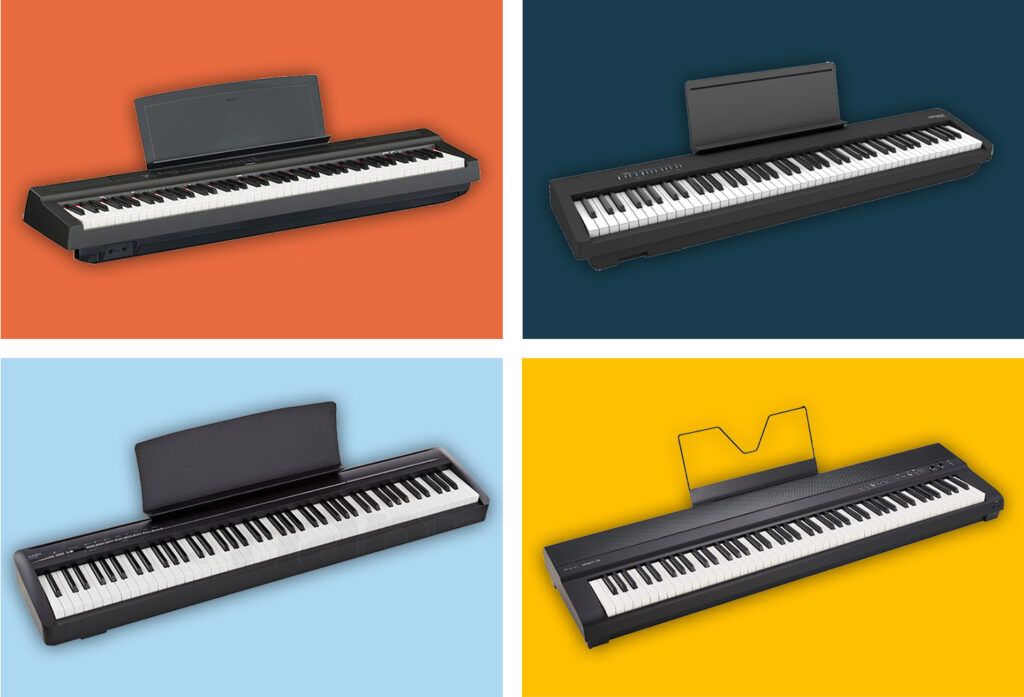Today, modern compact keyboards are the preferred choice for beginners. Technology has advanced to the point where comprehensive piano simulations are possible in very small cases that take up little space in the home - not everyone has room for a real grand piano at home.
Modern keyboards sound incredibly good and realistic, and the high-quality keyboard with scaled hammer action gives you the feeling of playing a real grand piano. Another advantage is that you can play at night with headphones without disturbing your neighbors - something you cannot do with an acoustic piano in your apartment.
Keyboards have never been in such demand as they are today, and the supply has increased accordingly. The good news is that it has never been easier or cheaper to learn to play the piano - you can get a good keyboard for just over 200 Euros. However, with so much to choose from, it can be difficult to make the right choice.
Of course, you want to make sure that you get the best keyboard for beginners that you can use for hours of practice and maybe even small live gigs. That's why we've put together this in-depth guide to the best beginner keyboards in 2023.
The best keyboards for beginners in 2023
Roland FP-10
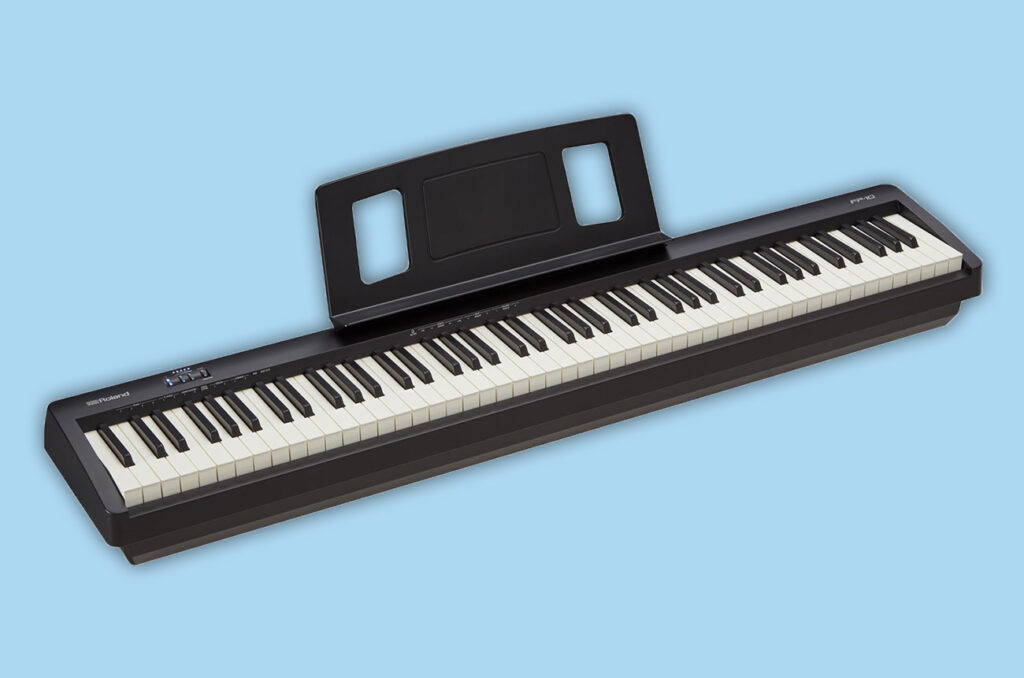
TECHNICAL SPECS
Number of keys: 88
Key type: Keys with hammer action
Velocity-sensitive keys: Yes
Sounds: 4x Piano, 2x E-Piano, 2x Harpsichord, 1x Vibraphone, 2x Organ, 2x Strings
Battery operated: No
Built-in speakers: 2x 6 Watt
Connections: USB-A, USB-B, Sustain Pedal Input, 3.5mm Stereo Jack
Extras: Bluetooth functionality
Weight: 12.3 kg
MODELS / PRICES
ARGUMENTS IN FAVOR
- High quality sounds
- Very good price-performance ratio
- Good build quality
NEGATIVE POINTS
- Speakers could have more bass
Available since 2019, this beginner's keyboard from Roland offers a lot for a very good price. The 88 fully weighted keys feel very high quality and are velocity sensitive (meaning the keyboard detects how hard or lightly you press the keys, and sounds louder or softer accordingly).
Roland officially calls this a "hammer action" keyboard, but the keys are quite light. For beginners, however, this should not be a problem and the keys still offer a very good and authentic playing feel.
This keyboard for beginners is particularly convincing because of its sounds, which - as usual with Roland - sound fantastic and authentic. It doesn't sound like a cheap digital piano. And surprisingly, the non-piano sounds (organ, harpsichord, etc.) are also very convincing and usable.
The only drawback is that this keyboard has no display, so the operation, especially the instrument selection, is a bit primitive. You have to hold down the function key while selecting another sound with the keyboard. This is simple in principle, but a bit old-fashioned. And in this price range, other beginner's keyboards already have displays.
However, Roland has compensated for this by allowing you to control the Roland FR-10 via a mobile phone app - the operation is more intuitive via the app. This is possible because this keyboard has Bluetooth.
Yamaha P-145 B
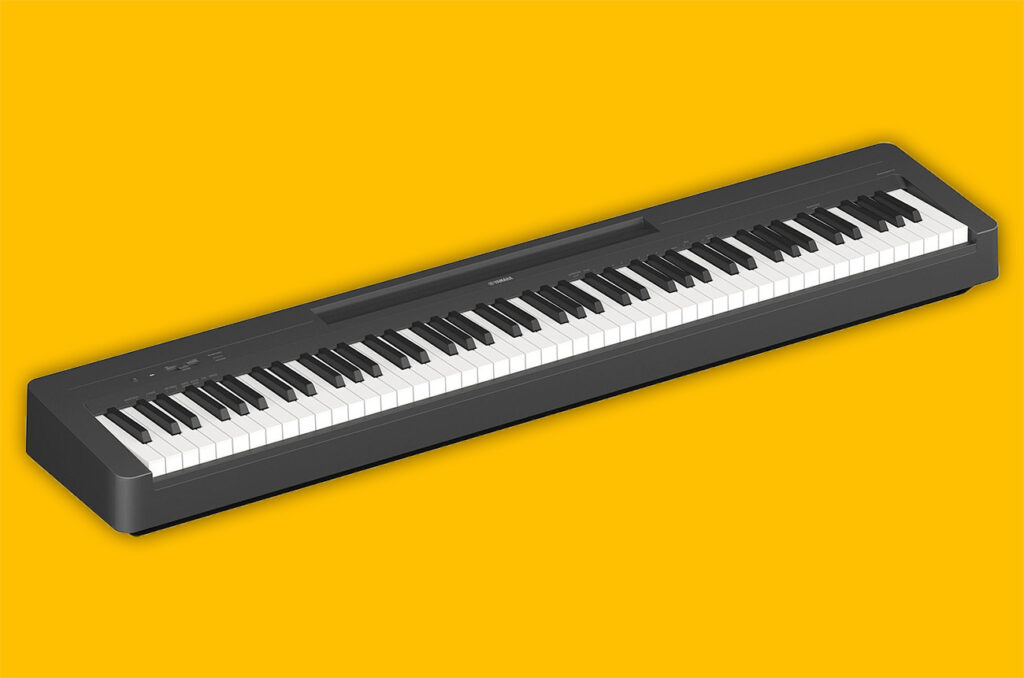
TECHNICAL SPECS
Number of keys: 88
Key type: Graded Hammer Compact
Velocity-sensitive keys: Yes
Sounds: 2x Piano, 2x E-Piano, 2x Organ, 1x Harpsichord, 1x Accordion, 1x Dizi (flute of traditional Chinese music), 1x Strings
Battery operated: No
Built-in speakers: 2x 7 Watt
Connections: USB-B, Sustain Pedal Input, Pedal Unit LP-5A, 6.3mm Stereo Jack
Extras: Smart Pianist App
Weight: 11.1 kg
MODELS / PRICES
Yamaha P-145 B (559 €)
ARGUMENTS IN FAVOR
- Incredible piano sound
- High-quality speakers produce a beautiful, spatial sound
- High quality keys
NEGATIVE POINTS
- Non-piano sounds are not particularly good
This beginner's keyboard is the successor of the well known Yamaha P-45, the most popular model of Yamaha, the largest piano manufacturer in the world. The price is a bit higher, but the quality is unbeatable.
With its high quality Graded Hammer Compact (GHC) 88-key weighted keyboard, this keyboard offers an incredible playing feel that comes very close to that of a real piano. The keys are heavy and very touch sensitive.
"Graded Hammer" means that the lower keys are heavier than the higher ones - just like on a real piano. However, they are not as heavy as on a grand piano, which is a great advantage for beginners.
The 10 sounds sound very good, especially the piano sound, which comes from a real CFIIIS grand piano. The 2 piano sounds are unbeatable and sound slightly better than Roland's, all other sounds (organ, strings, etc.) sound slightly better on the Roland keyboard. But I suspect that very few people would want to buy such a keyboard for organ or string sounds - the piano sound is most important in this case.
In addition, this beginner's keyboard offers 50 internal preset songs and 303 additional songs to learn via the Smart Pianist app. To use this app, simply connect your phone (Android or iOS) to the keyboard with a cable. You can do much more with this app, such as record, adjust the sound, split the keyboard, or create different layers of sound.
Thomann SP-320
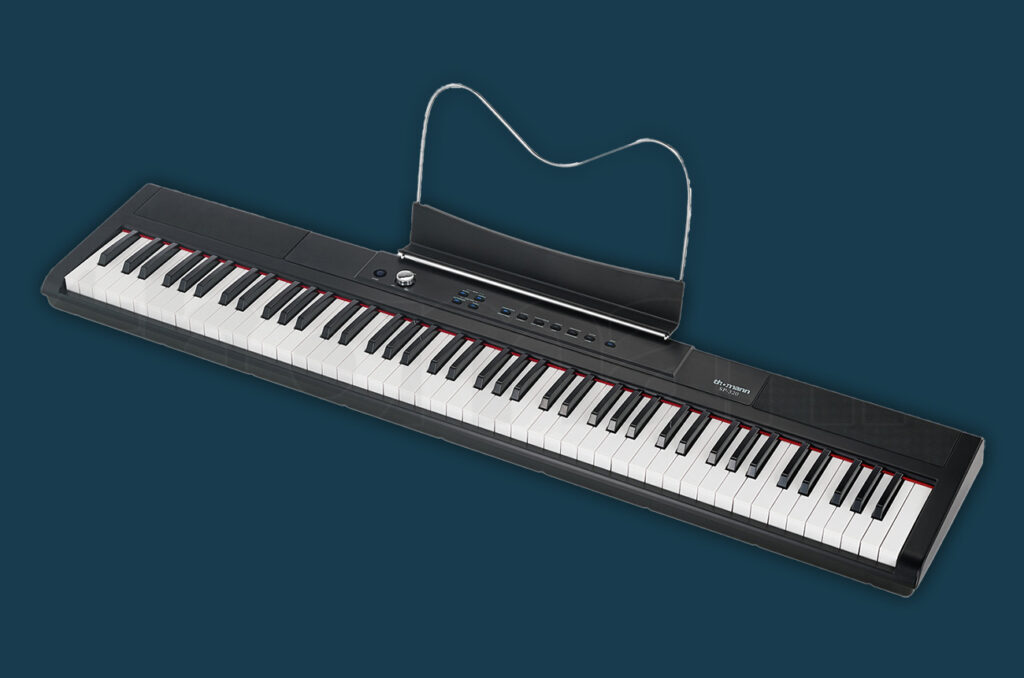
TECHNICAL SPECS
Number of keys: 88
Key type: Semi-weighted
Velocity-sensitive keys: Yes
Sounds: 2x Piano, 2x E-Piano, 2x Organ, 1x Strings, 1x Bass, 1x Vibraphone, 1x Harpsichord, 1x Guitar, 1x Choir
Battery operated: Yes
Built-in speakers: 2x 20 Watt
Connections: USB-B, sustain pedal input, RCA line-out (stereo), 6.3mm stereo jack
Extras: –
Weight: 9 kg
MODELS / PRICES
Thomann SP-320 (239 €)
Thomann SP-320 Bundle (379 €)
ARGUMENTS IN FAVOR
- Unbeatable price
- Speakers have a lot of power
NEGATIVE POINTS
- Keys are not fully weighted
This entry-level keyboard is the cheapest of the entire comparison. Unlike the previous two models, the keys of the SP-320 are not fully weighted, but only half weighted. This means that the playing feel of this entry-level keyboard doesn't quite match that of a real piano, but in order to keep the price so low, compromises had to be made.
Otherwise, this digital piano has a lot to offer: 88 keys, 12 different sounds that can be selected from the front panel, 12 demo songs and a built-in metronome. The latter is especially useful for beginners who want to practice rhythm.
What's special about this keyboard is that you can run it on batteries without a power supply, making it a great keyboard for traveling. Want to take it to the park and give a little concert? No problem, just insert the 6x LR20 D batteries that you can buy everywhere.
A chorus and reverb effect are built in to add depth to the sound. The built-in speakers are quite loud for a digital piano (20W each), which is nice. Especially if you want to play small concerts with the SP-320 without a PA.
All in all, this is one of the best keyboards for beginners because it is cheap and has a lot of features. However, if you are looking for hammer action keys, there are better models out there.
Korg B2 Black
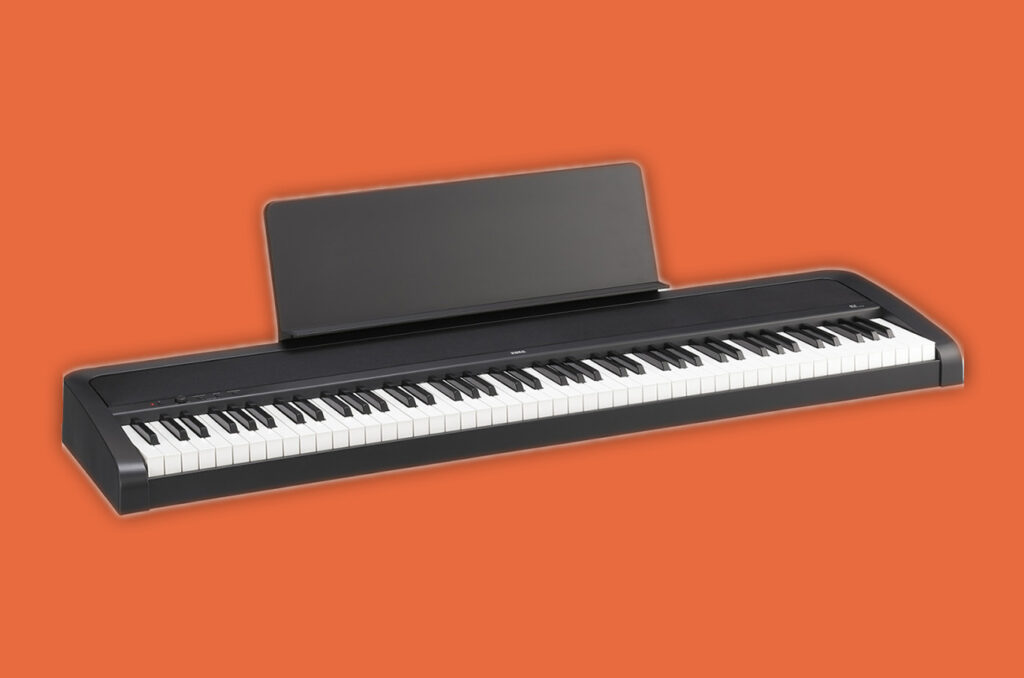
TECHNICAL SPECS
Number of keys: 88
Key type: NH Keyboard (Natural Weighted Hammer Action)
Velocity-sensitive keys: Yes
Sounds: 5x Piano, 3x E-Piano, 2x Organ, 1x Harpsichord, 1x Strings
Battery operated: No
Built-in speakers: 2x 15 Watt
Connections: USB-B, sustain pedal input, 3.5mm output (stereo), 3.5mm input (stereo)
Extras: Korg Modules, Korg Gadget 2 LE
Weight: 11.4 kg
MODELS / PRICES
Korg B2 Black (389 €)
Korg B2 SP Black (639 €)
ARGUMENTS IN FAVOR
- Realistic sound
- High quality keys
- Expandable sound modules
NEGATIVE POINTS
- App only available for iOS
The Korg B2 is a simple but high-quality keyboard for beginners, which scores especially with its keyboard. This is a newly developed NH keyboard (Natural Weighted Hammer Action), which offers a really realistic playing feel, but is not as heavy as a real grand piano. This makes playing much easier for beginners.
The piano sound of this keyboard is amazingly good, which is partly due to the multisampling method used on this instrument. With this method, up to three samples are played simultaneously for each key pressed, which is noticeable in the sound quality.
In addition, this beginner's keyboard has built-in speakers that can be quite loud and also reproduce music with incredible accuracy.
A great extra is the Korg Module App, which allows you to expand the sounds of this electric piano. Each module offers a new sound in a very high quality, so you can use this keyboard for beginners also for music production in the studio. The app includes the sounds of the most popular keyboards.
Also included is the Korg Gadget 2 LE app, a mobile DAW for iOS that lets you record and create complete productions without a computer. The app also includes all the sounds (drum machines, basses, etc.) that are playable on the Korg.
To use these apps, all you have to do is connect the Korg B2 to an iOS device via a USB cable and download the app. Unfortunately, the app is only available for iOS, so Android users are excluded (pretty uncool, Korg!).
On the back of the keyboard, you will find the usual ports with the special feature of the Audio IN port. Here you can connect external devices (such as your smartphone) and play music through the keyboard's built-in speakers - perfect for playing along and accompanying.
This electric piano is especially recommended for beginners who own an iPhone or iPad, because only with this device all functions can be used.
Thomann SP-5600
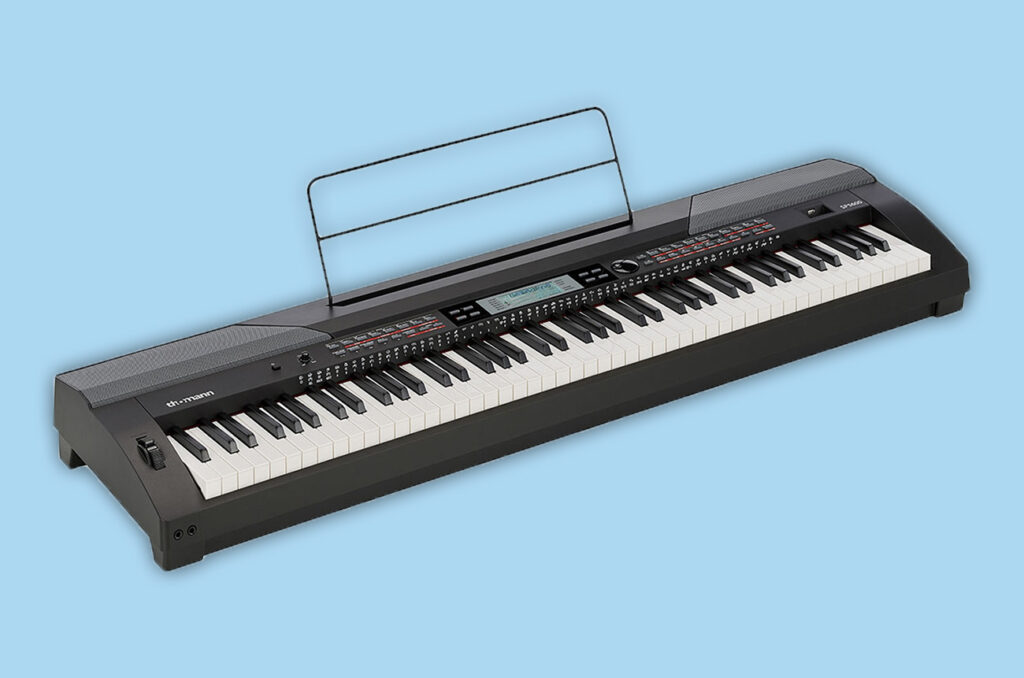
TECHNICAL SPECS
Number of keys: 88
Key type: Keyboard with hammer action
Velocity-sensitive keys: Yes
Sounds: 600 sounds (many different sounds included)
Battery operated: No
Built-in speakers: 2x 10 Watt
Connections: USB-B, MIDI IN/OUT, sustain pedal input, 6.3mm stereo output, 6.3mm stereo input, microphone input, 2x 6.3mm headphone output
Extras: Sequencer, DSP effects
Weight: 13.8 kg
MODELS / PRICES
Thomann SP-5600 (398 €)
ARGUMENTS IN FAVOR
- 600 sounds
- Simulation of an entire band with advanced sequencing options
- Twinova and lesson mode make learning easier
NEGATIVE POINTS
- Sound quality could be better
This electric piano is packed with features at an unbeatable price. With 600 different sounds - even drum sounds are included - you can play virtually any instrument. With 230 built-in rhythms, this keyboard is perfect for beginners or as an entertainer's keyboard for a one-man show.
The keyboard is of high quality and equipped with a hammer action for a realistic playing feel. The keys are relatively heavy, like a classical grand piano. The keyboard can be easily "split" to assign different sounds to different ranges, and you can save the settings in a total of 48 memory locations for instant recall.
But that's not all: this keyboard from Thomann even has a built-in sequencer. This allows you to record and save different melodies and sounds separately, even on USB if you wish, so that you can edit them externally.
Interesting are the Twinova and Lesson modes, which are specially designed for teaching. Twinova mode allows the keyboard to be divided into two equal sections so that the teacher and student can play at the same time (and in the same range). In Lesson mode, there are 120 learning songs where the melody is suppressed so the pianist can play it.
The built-in speakers are not particularly loud at 10W, but sufficient for living room volume. In addition to the stereo IN/OUT, the keyboard also has a microphone input with preamp, so that live singing is also possible.
Yamaha P-125A
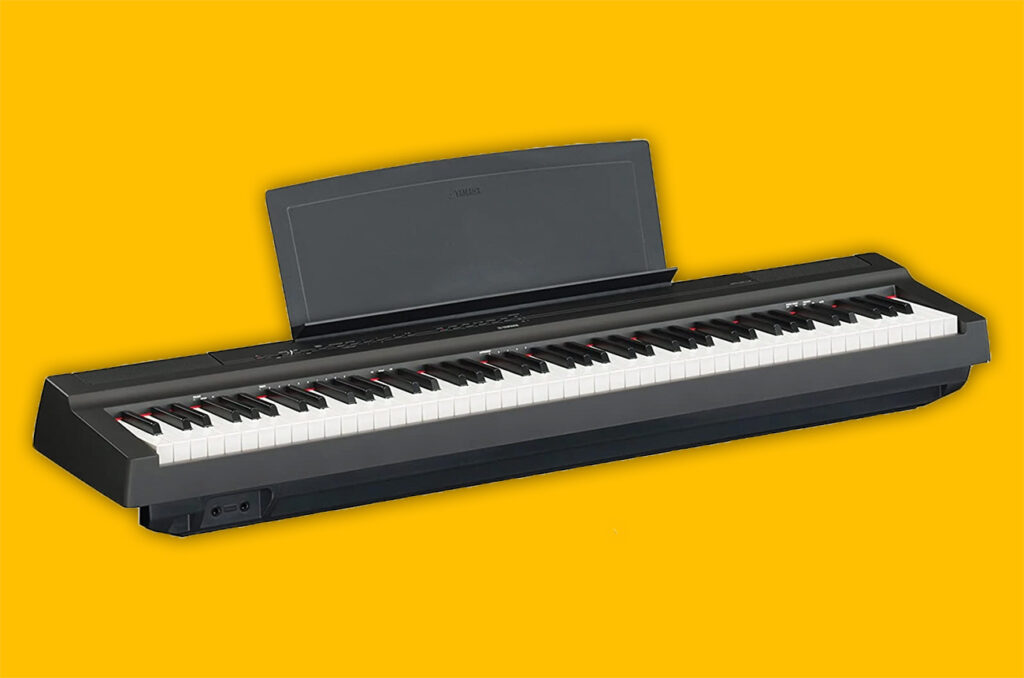
TECHNICAL SPECS
Number of keys: 88
Key type: Graded Hammer Standard Keyboard
Velocity-sensitive keys: Yes
Sounds: 4 Pianos, 4 E-Pianos, 4 Organs, Clavinet, Vibraphone, 4 Strings
Battery operated: No
Built-in speakers: 2x 7 Watt
Connections: USB-B, sustain pedal input, stereo output, pedal unit
Extras: "Smart Pianist" App
Weight: 11.8 kg
MODELS / PRICES
Yamaha P-125A BK (549 €)
Yamaha P-125A WH (639 €)
Yamaha P-125A BK Home Bundle (729 €)
Yamaha P-125A WH Home Bundle (829 €)
ARGUMENTS IN FAVOR
- High-quality keyboard with very realistic feel
- Very good piano sound
- Smart Pianist App
NEGATIVE POINTS
- –
This beginner's keyboard from Yamaha excels with its piano sound: As with the Yamaha P-145, the piano sounds come from a Yamaha CFIIIS concert grand piano, a very brilliant and warm piano known worldwide for its sound.
But the Yamaha can do more than just grand piano sounds: the total of 24 sounds are all of very high quality, as they come from the Pure CF Sound Engine. Especially the electric pianos (Rhodes and Wurlitzer sound) sound very true to the original. There are also organ, string, bass and clavinet sounds.
The keyboard is, like the other Yamaha models, a very high quality GHS keyboard that offers a playing feel very close to that of a real piano. The keys are heavy - especially the low keys are the heaviest on this keyboard - so it should be easy to switch to a real piano later.
Operation is very simple, even though there is no built-in display. The instruments can be selected directly from the front panel, and additional functions such as metronome, rhythm accompaniment, etc. can be activated. Some functions can also be accessed from the keyboard.
This beginner's keyboard comes with 20 accompaniment rhythms consisting of drums and bass. 21 demo songs and 50 piano songs are also included. It's even possible to record up to two tracks - so you can record a simple piano song.
Again, Yamaha offers control via the Smart Pianist app on your smartphone (Android and iOS), which makes operation a little easier and more intuitive.
Kawai ES-120 B
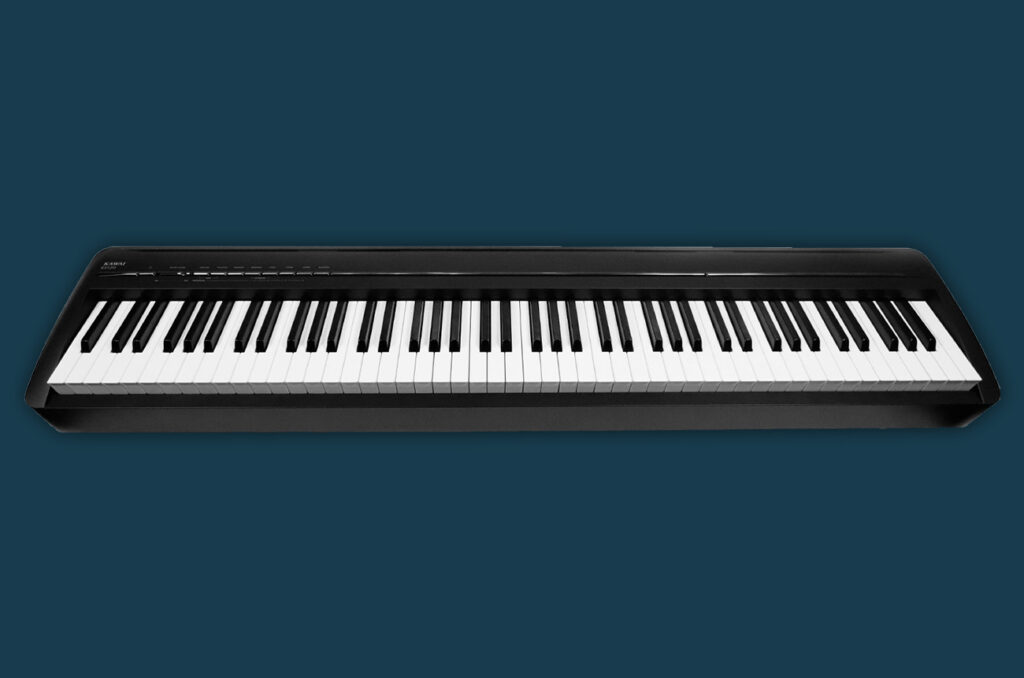
TECHNICAL SPECS
Number of keys: 88
Key type: Responsive Hammer Compact
Velocity-sensitive keys: Yes
Sounds: 8 Pianos, 4 E-Pianos, 4 Organs, Vibraphone, Harpsichord, Wood Brass & Ride, Electric Bass, Wood Bass, New Age Pad, Choir, String Ensemble, Slow Strings
Battery operated: No
Built-in speakers: 2x 10 Watt
Connections: USB-B, Damper Pedal, Pedal Unit, L/R Line Out
Extras: Virtual Technician App
Weight: 12 kg
MODELS / PRICES
ARGUMENTS IN FAVOR
- High quality keys
- Very good piano sound
NEGATIVE POINTS
- Virtual Technician App only available for iOS
- Organ and electric piano sounds are not really usable
This keyboard for beginners from Kawai is characterized by its minimalistic and very elegant design. With a relatively small housing and a narrow control bar, the piano offers a very clear interface, although this means that many function keys are assigned twice. This means that some functions are not as directly accessible as on other electric pianos.
The "Responsive Hammer Compact" keys are fully weighted, very high quality and feel very good when playing. They are not as heavy as other models, which makes playing easier for beginners. The keyboard can be split to assign different sounds to different zones, and there is also a dual mode to split the keyboard into 2 zones but playing in the same position (for teacher-student practice).
100 drum rhythms for accompaniment are included, which is of course very practical for practicing on your own. In total, this keyboard for beginners offers 25 different sounds, of which the pianos sound very good, but the organs and electric pianos could be improved. The sounds can be edited in detail using the "Virtual Technician" app, which is unfortunately only available for the iPad.
The built-in recorder can record up to 15,000 notes (about 3 songs). Some additional functions are activated by different key combinations: You can layer different sounds, select six different reverb types, adjust velocity, transpose, or tune.
The two 10W speakers are perfectly adequate for practicing in the living room, and at 12 kg, this electric piano is not too heavy. Highly recommended if you value elegant design.
Thomann DP-26
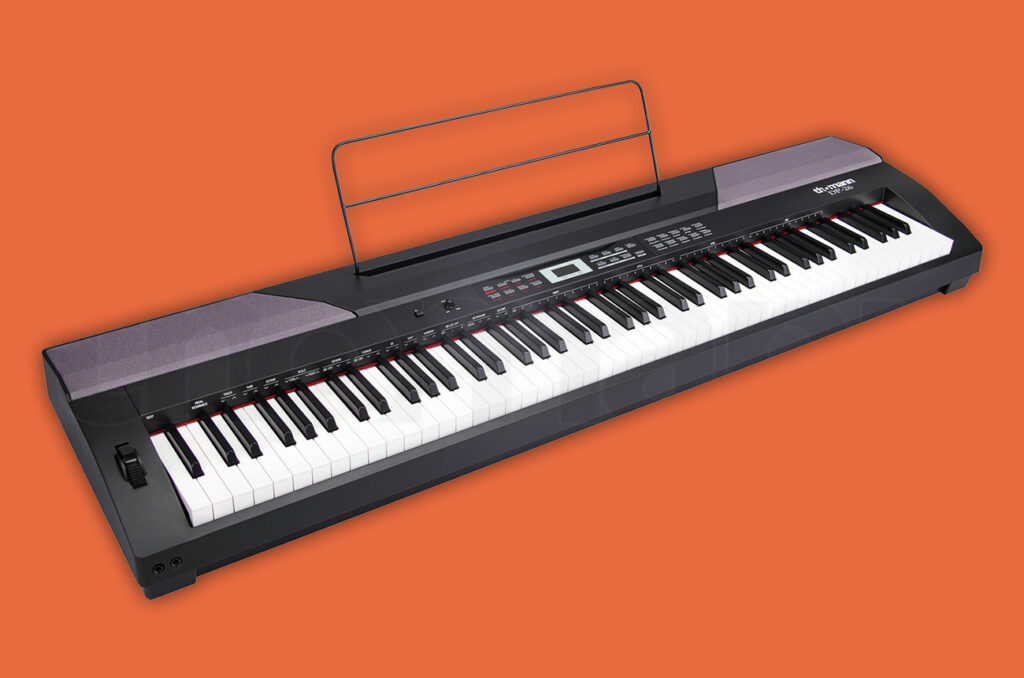
TECHNICAL SPECS
Number of keys: 88
Key type: Weighted keyboard with hammer action
Velocity-sensitive keys: Yes
Sounds: 2 pianos, 3 electric pianos, harpsichord, clavinet, vibraphone, 5 organs, accordion, harmonic, 2 guitars, Bass guitar, strings, Synth
Battery operated: No
Built-in speakers: 2x 10 Watt
Connections: USB-B, MIDI-Out, Sustain Pedal, Stereo IN/OUT, 2 headphone outputs
Extras: Pitch Bend Wheel
Weight: 12.9 kg
MODELS / PRICES
Thomann DP-26 (329 €)
Thomann DP-26 Set (365 €)
ARGUMENTS IN FAVOR
- Very good value for the money
- Good piano sound
- MIDI output for controlling external synthesizers
NEGATIVE POINTS
- Electric piano and organ sounds could be improved
- Aesthetics
With the DP-26, Thomann has once again released a great keyboard for beginners that offers a lot of features at an incredible price. With 88 weighted hammer action keys that play amazingly well (even if the feel isn't as good as Yamaha's), a built-in display and 20 different sounds for only 329 Euros, this electric piano is hard to beat in terms of value for money.
The different sounds can be layered, or the keyboard can be divided to play different instruments in different octaves. The keyboard can also be divided into two sections of the same pitch for practicing in pairs. The recording function can be used to capture ideas - up to 5 songs can be recorded and stored in total.
Visually, this beginner's keyboard is not very attractive in my opinion, but that is a matter of taste. The two gray 10W speakers are immediately noticeable. A practical music holder is built in and of course the pitch bend wheel, which is rather unusual for electric pianos of this type.
The two piano sounds sound amazingly good and true to the original, but all other sounds are unfortunately unusable. So if you only want piano sounds, this keyboard is a good choice, but if you want electric pianos and organs, it is not.
Nevertheless, this keyboard is an absolute bargain for beginners, because for 329 Euros you get a great electric piano with a very good feel, a good keyboard and many functions.
Casio CDP-S110
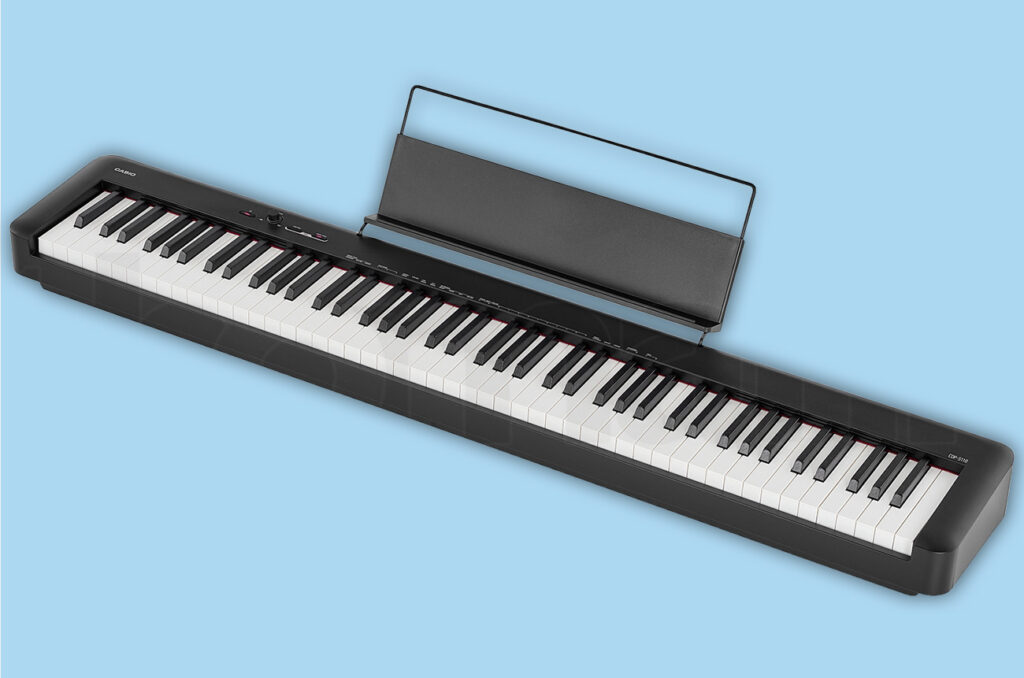
TECHNICAL SPECS
Number of keys: 88
Key type: Scaled Hammer Action Keyboard II
Velocity-sensitive keys: Yes
Sounds: 3 pianos, 3 electric pianos, harpsichord, strings, 2 organs
Battery operated: Yes
Built-in speakers: 2x 8 Watt
Connections: USB-B, Damper Pedal, Headphone Out, Stereo Input
Extras: CASIO MUSIC SPACE App
Weight: 10,5 kg
MODELS / PRICES
Casio CDP-S110 BK (369 €)
Casio CDP-S110 WH (389 €)
Casio CDP-S110 BK Deluxe Bundle (565 €)
Casio CDP-S110 WH Deluxe Bundle (575 €)
ARGUMENTS IN FAVOR
- Realistic feel when playing
- Very good piano sound
- Can be operated with batteries
NEGATIVE POINTS
- –
The Casio DCP-S110 is an elegant, simple, but very high quality keyboard that stands out for its simple control panel. It consists of only three keys and a volume control, but allows a variety of functions through key combinations. This makes the keyboard very compact, with a depth of only 23 cm and a height of 10 cm.
Particularly noteworthy is the quality of the keyboard, which has a scaled hammer action. This means that the low keys are heavier than the high ones, just like on a real grand piano. And this is not a matter of course for an electric piano under 400 €!
A great feature of this beginner's keyboard is that it runs on standard AA batteries. This means that you can take this compact electric piano with you wherever you go and play it even without a power supply, for example in the park or garden. The two built-in 8W speakers are not particularly loud, but should be sufficient for the immediate environment.
The sounds are surprisingly good for an electric piano in this price range, even the non-piano sounds are quite usable. You can layer the different sounds to create completely new sounds. Reverb and chorus effects are available to make the sound even more interesting.
The CASIO MUSIC SPACE app, available for iOS and Android, makes playing an electric piano even easier and more intuitive. All parameters can be edited, and everything is directly visible and tangible. The app also offers a number of learning options - up to 60 classical pieces can be learned playfully on the screen.
All in all, I think it's the best keyboard for beginners under 400€.
Roland FP-30X
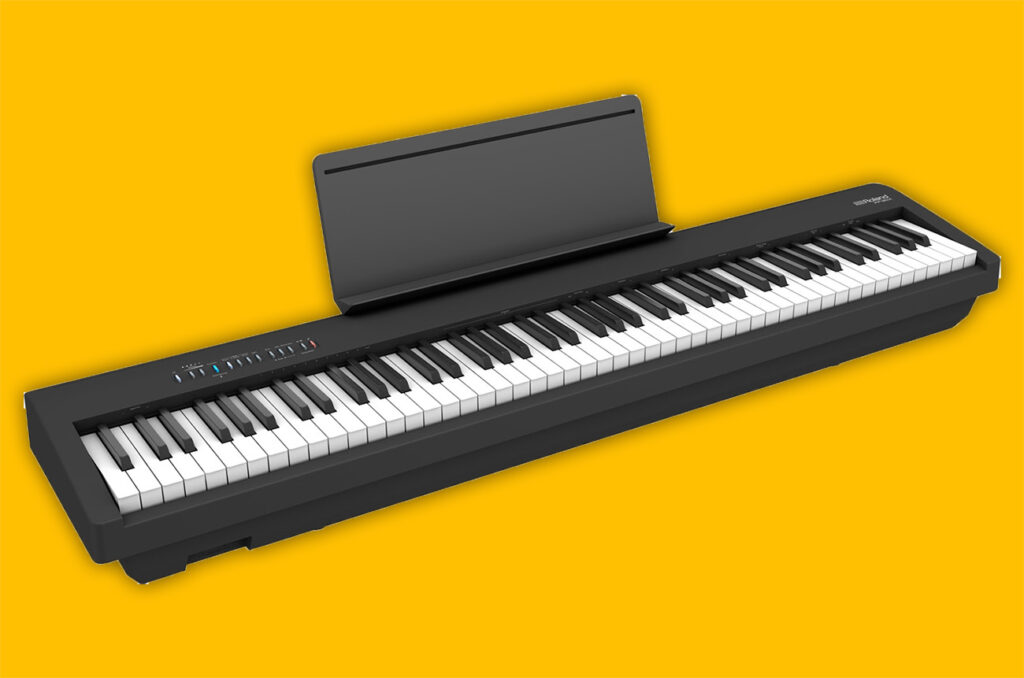
TECHNICAL SPECS
Number of keys: 88
Key type: PHA-4 Keyboard with Ivory Feel
Velocity-sensitive keys: Yes
Sounds: 12 Supernatural Piano, 20 E-Pianos, 24 other sounds
Battery operated: No
Built-in speakers: 2x 11 Watt
Connections: USB-B, USB-A for ext. memory, L/R output, sustain pedal, pedal unit, 3.5 mm headphone output, 6.3 mm headphone output
Extras: Recording and playback of MIDI and audio files, Piano Designer App
Weight: 14.8 kg
MODELS / PRICES
Roland FP-30X BK (629 €)
Roland FP-30X WH (669 €)
Roland FP-30X BK Home Bundle (929 €)
Roland FP-30X WH Home Bundle (949 €)
ARGUMENTS IN FAVOR
- Very natural piano sounds
- High quality keys
- Useful other sounds
- MIDI recording to USB storage device
NEGATIVE POINTS
- The operation is somewhat awkward
The FP-30X is the big brother of the FR-10 and offers some additional features. This beginner keyboard from Roland uses 12 "Supernatural" piano sounds that sound incredibly realistic. In combination with the PHA-4 keyboard with Ivory touch, it creates the feeling of playing a real grand piano.
Interestingly, Roland has dispensed with knobs as controls - there are only 13 elegant buttons on the control panel, which can be used to select all functions. In combination with the buttons, you can turn the metronome on and off, change the tempo, select the different sounds, or turn on an accompaniment.
The speakers sound incredibly good for a keyboard - they sound spacious and warm, which adds to the feeling of playing a real grand piano. It is also very convenient that there are two headphone jacks on the front, not just one. This allows two people (student and teacher) to practice with headphones at night without disturbing the neighbors.
Also very useful is the ability to record and play back MIDI via USB. This way, you can record your performance and listen to and edit it later in your DAW, but you can also create MIDI files in your DAW and play them back through the electric piano.
You can also connect this keyboard to an iOS or Android device via Bluetooth and control it through the Piano Designer app. This allows you to change parameters such as the degree of piano lid opening or damper resonance - a world of sound design possibilities.
Casio PX-S1100
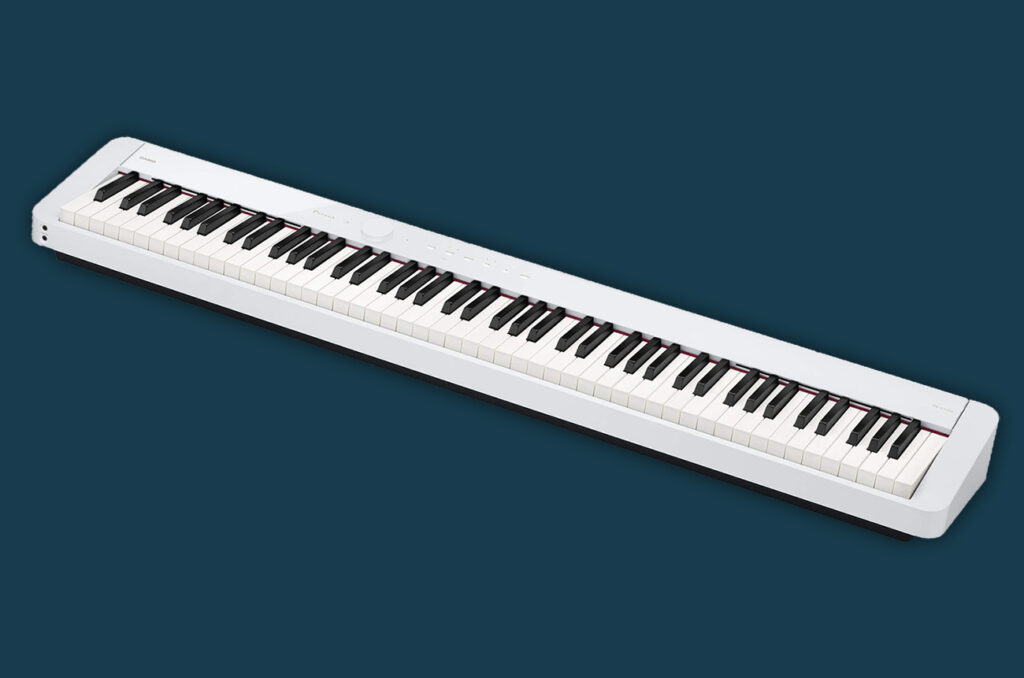
TECHNICAL SPECS
Number of keys: 88
Key type: Keyboard with scaled hammer action
Velocity-sensitive keys: Yes
Sounds: 5 Pianos, 4 E-Pianos, Harpsichord, Vibraphone, 2 Strings, 4 Organs, Bass
Battery operated: Yes
Built-in speakers: 2x 8 Watt
Connections: USB-B, USB-A for ext. memory, L/R output, damper pedal, pedal unit, 2x 3.5 mm headphone output
Extras: Transmission of MIDI via Bluetooth
Weight: 11.2 kg
MODELS / PRICES
ARGUMENTS IN FAVOR
- Very realistic piano sounds
- High quality keys
- Compact
NEGATIVE POINTS
- Non-piano sounds are not particularly good
This minimalist keyboard from Casio combines elegance and functionality in a relatively compact package. The weighted keyboard with scaled hammer action offers a very realistic feel, very close to that of a real grand piano. It is one of the best keyboards in its price range.
The front panel has only an on/off switch and a volume control; all other functions are controlled by touch sensors. And there are a lot of them: even the finest sound parameters, such as damper or string resonance, can be edited to shape the sound as desired.
The piano sound of this entry-level keyboard is impressive - the sound is bright and brilliant and you can adjust almost all parameters to your liking. The electric pianos, strings and harpsichord are okay, but all the other sounds are rather mediocre and not really usable in my opinion.
This keyboard for beginners has an impressive DSP engine for an electric piano in this price range, with 4 types of reverb, surround effects and 4 chorus effects. The effects sound very good and add some depth to the sound - especially the Wurlitzer chorus combination sounds very nice.
A Bluetooth adapter is included to connect the piano to a smartphone or tablet. This opens up even more possibilities, such as MIDI or audio recording via Bluetooth, as well as a variety of learning functions.
The built-in speakers sound really good and pleasant and are loud enough. This is especially worth mentioning because this keyboard is so compact.
Thomann DP-28 Plus
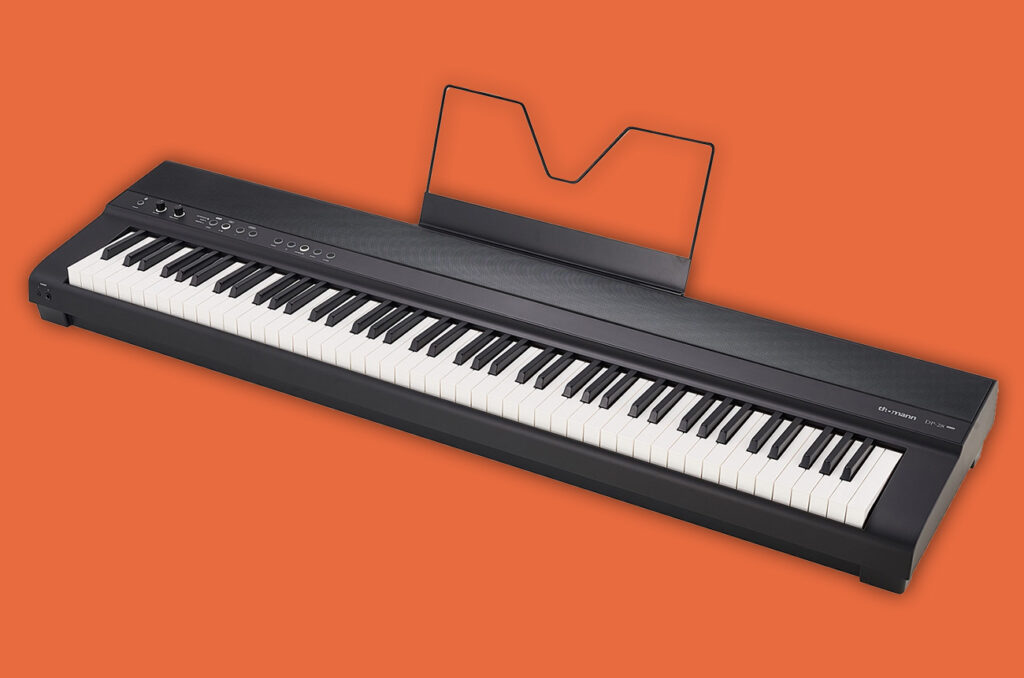
TECHNICAL SPECS
Number of keys: 88
Key type: Keyboard with hammer action
Velocity-sensitive keys: Yes
Sounds: 5x Piano, 5x E-Piano, Clavinet, Harpsichord, 3x Organ, 5 Synths, Bell, Celesta, Nylon Guitar, E-Bass, Acoustic Bass
Battery operated: No
Built-in speakers: 2x 20 Watt
Connections: USB-B, Line-Out, Sustain Pedal, Aux In, MIDI-Out, 3.5mm Headphone Out, 6.3mm Headphone Out
Extras: Piano ToolBox App
Weight: 12,5 kg
MODELS / PRICES
Thomann DP-28 Plus (389 €)
Thomann DP-28 Plus WH (395 €)
ARGUMENTS IN FAVOR
- Good sounds
- Good keys
- Very good value for the money
NEGATIVE POINTS
- Line-out is a bit noisy
The Thomann DP-28 Plus is a great keyboard for beginners because of its affordable price. This electric piano comes with 25 sounds, a metronome, 50 rhythms for accompaniment, and much more.
The 88 keys are fully weighted with hammer action and significantly heavier than other Thomann models. This has a positive effect and provides a more realistic playing feel.
This beginner's keyboard also scores with its looks, as the design is minimalist, elegant, and stylish. The control surface basically consists of the speakers that run horizontally across the entire width. On the left side, there are 8 buttons and 2 sliders to control all the functions.
The sound quality of the 25 sounds is good, especially the pianos and electric pianos. It is positive that you can adjust so many sound parameters, such as resonance or damper noise, to refine the sound down to the smallest detail. In a direct comparison, however, other models in the price range of up to 500 € (Yamaha or Roland) sound a little bit better and more detailed.
The keyboard has Bluetooth functionality, allowing it to connect to the Piano ToolBox app on a smartphone. This makes setting up effects, layers, or splits much easier and more intuitive - even displaying images of the recreated pianos and instruments.
There's no shortage of connectivity options - in addition to the usual line out, pedal and USB ports, there's a MIDI out (ideal for connecting the keyboard to a synthesizer) and two headphone outputs on the front, so two people can listen at the same time.
This is what you should look for when buying
Good keys
If you are learning to play the piano, you will definitely need a keyboard with 88 fully weighted keys and a hammer action. This is the only way to get the feel of a real piano, which is what you will probably be practicing on in class and maybe even playing live later.
Keyboards with scaled hammer action even have the advantage that the low keys are heavier than the high keys, just like on a real piano. If this is important to you, you should definitely choose this type of keyboards.
Sounds
Of course, you should ask yourself if you only need a good piano sound or if you also want to play other instruments like organ or electric piano. Because the keyboards in this comparison all sound good in piano sound, but not all of them have realistic and usable organ, electric piano or other sounds.
You can also use the electric piano as a MIDI keyboard and play the sounds from your DAW, but not everyone has this option. So think carefully if your needs might grow in the future.
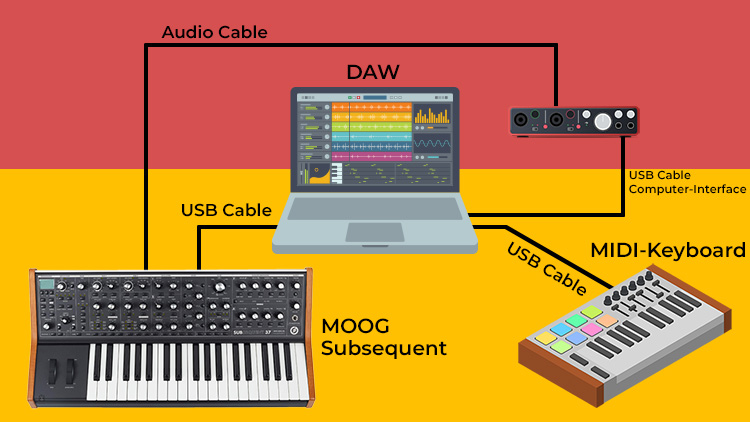
Extra functions
Most entry-level keyboards offer many additional features, such as cable or Bluetooth connectivity to your smartphone. This gives you more control and makes it easier to use.
Some keyboards even offer the ability to record and save MIDI and audio. This is a great way to get started composing and producing, or to record your own performances for later evaluation.
Most keyboards come with a variety of learning aids, such as the ability to play popular songs with accompaniment or read music directly from the display. So think carefully about what you need (and don't need) and whether it's worth spending more money for more features.
Can the keyboard be operated with batteries?
Some keyboards can run on batteries, making them mobile and independent of the mains, which is very handy if you want to take the keyboard to a place without electricity, such as in the garden or on the street. So if you plan to use your keyboard for small street concerts, this is a feature you should take advantage of.
Frequently asked questions
What is a velocity-sensitive keyboard?
A velocity-sensitive keyboard has a keyboard where the sound produced depends on how hard or soft the keys are pressed. It mirrors the mechanism of a conventional acoustic piano, where the speed at which the keys are struck determines the volume and character of the sound produced.
When you press a key on an acoustic piano quickly or hard, the hammer inside the piano strikes the string faster, producing a louder sound. On the other hand, if you press the key slowly or gently, the hammer strikes the string more slowly, producing a softer sound.
With a touch-sensitive keyboard or digital piano, this behavior is mimicked electronically. The harder or faster you press a key, the louder the sound. If you press a key softly or slowly, the sound becomes softer.
What connections does a good keyboard for beginners need?
The most important is the headphone jack, where you can plug in your headphones and hear the entire signal in stereo. Some also have a line output (usually stereo) for connecting to a mixer or PA.
Some keyboards also have an audio input, so you can plug an external audio source into the keyboard and listen while you play. This is handy if you want to practice on familiar songs.
All beginner's keyboards have a USB-B port that allows you to connect the piano to your computer to transfer MIDI. This allows you to play VST instruments in your DAW. Some keyboards also have a MIDI output, which is very handy for playing external analog synthesizers.
What accessories do I need for my keyboard?
You will definitely need a stand to place your electric piano on. There are high-quality stands for every keyboard that simulate an upright piano and look very stylish. If they are too expensive for you, there are also classic stands like this one that are much cheaper.
Next, you'll need a keyboard bench that allows you to play in an upright position. There are models ranging from $20 to over $200, but for beginners, simple models like this one from Millenium should suffice.
I also recommend a good pair of headphones for practicing - especially in the beginning, you can quickly annoy the other family members if you practice loudly for a long time. Check out our comparison of the best headphones - you'll find models in every price range.
Keep reading:





